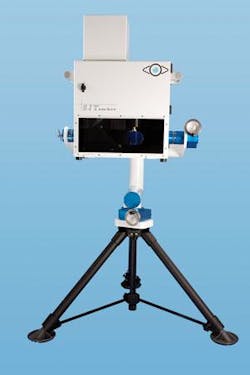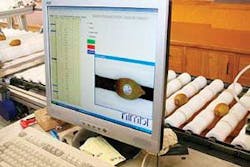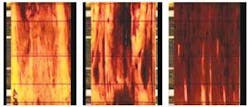Snapshots
High-speed objects caught in 3-D
To correlate analytical and visual data over part of an object’s flight, Specialised Imaging (Tring, UK; www.specialised-imaging.com) has developed a system that allows engineers to correlate high-speed video data with 3-D visualization and measurement. Using a pair of Trajectory Tracker systems with flight-prediction algorithms and high-speed video cameras, engineers can capture sequences of images along an objects flight path and obtain 3-D measurements from those sequences.
Proof-of-principle tests in the USA and Europe have used the system to obtain a variety of measurements, accelerating the process of characterizing the flight behavior of fast-moving objects. To evaluate failure modes of high-speed objects, their performance over a portion of the trajectory must be measured. The Trajectory Tracker allows in-flight behavior of high-speed objects to be made over more than 100 m. The resulting slow-motion record of an object in flight allows diagnosis of events such as fin deployment, motor burn time, pitch, yaw, and spin rate.
Pedestrian crossing
With funding from the US Department of Transportation, Migma Systems (Walpole, MA, USA; www.migmasys.com) has developed a stereo-based vision system to detect pedestrians. The pedestrian early-warning system consists of a stereo camera, a digital-signal processor, and a traffic controller and is intended to be deployed at a street intersection, continuously monitoring the crosswalk for pedestrians. If pedestrians are detected, a wireless signal is sent to a traffic controller that changes the traffic signal lights.
The IR stereo camera is equipped with 48 IR LEDs emitting at 850 nm, ensuring that the camera has sufficient illumination to provide reliable detection in dim light and at night. A light-sensing device automatically turns on or off the LED emitters based on outdoor light intensity. With these emitters, the stereo camera can detect pedestrians 60 ft away. The system is intended to be mounted 16–24 ft above ground and communicates wirelessly in all weather conditions.
Good grades for kiwifruit
An automated kiwifruit packing system developed at Massey University (Auckland, New Zealand; www.massey.ac.nz) means buyers will receive exactly the grade of kiwifruit they require at the right stage of ripeness. Designed by Rory Flemmer in conjunction with Zespri (Antwerp, Belgium; www.zespri.com), the system uses machine vision to grade fruit according to the amount of blemishing and soft spots, as well as to perform labeling and packing functions. Initially, the packing line consists of one robot and one production line, but the completed system with nine robots and four production lines will pack 250–400 trays of fruit per hour.
After the fruit is measured for ripeness and weighed to within 0.1 g, the shape and color of blemishes is measured. The fruit is then labeled and placed by the robot in packing trays. The kiwifruit packer is adaptable to pack almost any type of fruit or vegetable, Flemmer says, and will be operated by about two staff each shift. The next step is the production of an automated robot that will pick the kiwifruit from orchards.
A thin veneer
Plywood veneer moisture content can be very high if the wood is cut from a tree’s outer sapwood layer instead of its inner heartwood core. To maintain a good glue bond between plywood veneers and maximize veneer strength, plant operators must dry each sheet within a tightly controlled moisture range. A wet section of veneer in an otherwise dry heartwood sheet can make the sheet blow out inside the steam press, causing de-lamination of the plywood and result in lost production and increased costs. Plant operators have attempted to measure the moisture content and sort the green veneer panels, but have lacked the ability to measure both peak and average moisture contents with the necessary precision.
Because of this, Westmill Machine Automation (Aldergrove, BC, Canada; www.lightsort.ca) collaborated with Forintek Canada (Vancouver, BC, Canada; www.forintek.ca) and LightWave Computing (Vancouver, BC, Canada; www.lightwavecomputing.com) to develop LightSORT Green Veneer Moisture Measuring Technology for a vision-based moisture-sensing system. In this system, a pulsed LED linear light source penetrates the veneer on the conveyor. A linescan CCD camera digitizes the light intensity that passes through each sheet and sends it to a frame grabber. Depending on the veneer species and thickness, plant operators can adjust LED brightness to obtain the maximum dynamic range from the CCD camera. Because captured image intensity correlates closely with localized veneer moisture content, the system can analyze each panel for peak and average moisture content. A digital I/O module triggers downstream PLCs that control which panels are placed in specific bins.




